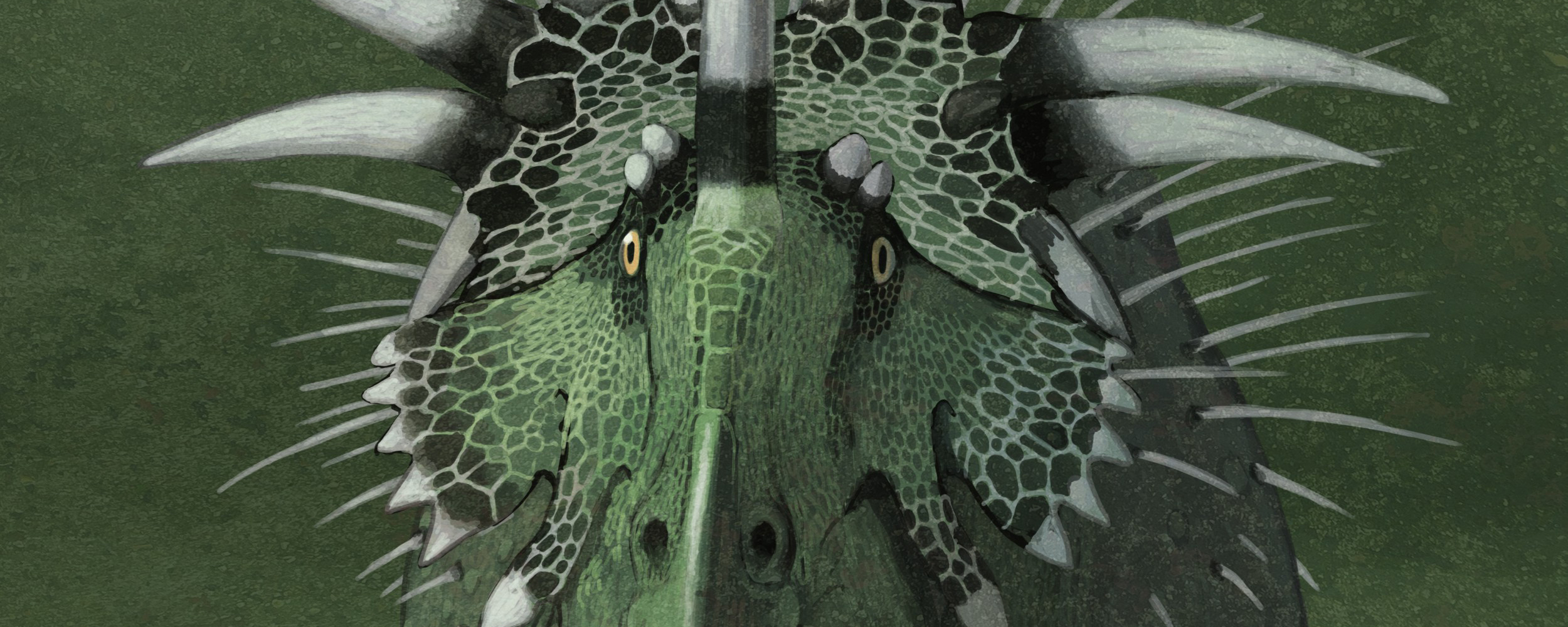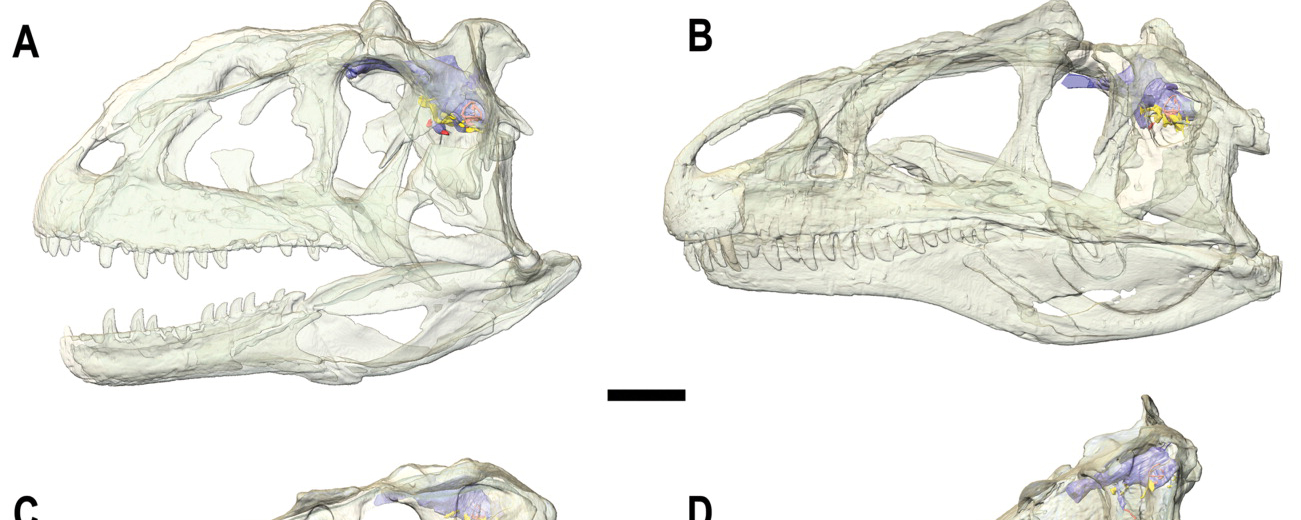


Key Points:
•Although brains and sense organs do not fossilize, there are some approaches that allow us to approximate the sensory abilities of extinct dinosaurs.
•The relative size of different portions of the dinosaurian brain allow us to interpret which functions were emphasized and which reduced in any given group of dinosaur.
•Non-avian dinosaur brain size is smaller than those of birds or mammals, but typically larger than those of crocodilians, lepidosaurs, and turtles.
•Dinosaur olfaction and vision seem to have been fairly well-developed, as was their sense of balance.
Dinosaur Brains
We can use biomechanics for understanding the sensory world of the dinosaurs. Brains and sense organs operate broadly similar across all vertebrates, and (in at least some cases) we have osteological correlates to aspects of the dinosaur sense organs.
One of the most important tools is the CT scanner. CT scans have given considerable new help in figuring out how dinosaurs lived and operated. For example, they help reveal the development of different lobes of the brain, as recorded in the endocast (the void left over when the brain decays:
The structure of vertebrate brains is fairly conserved across the clade, so we can identify which sections apply to which function. Some of the lobes have to do with particular senses. But of course one of the main functions of brains is "cognition" (that is, thinking.) What do scans of dinosaur brains tell us about how intelligent they were?
One issue to deal with is determining how "brainy" a given animal is. There are several issues here:
Overall, the brain is larger in birds and mammals than their other living relatives, and especially large in Telluraves among the birds and in Primates and a few other groups in mammals. We can estimate the size of dinosaur brains from their endocasts, with the understanding that in most dinosaurs (like most non-bird sauropsids) the brain did not entirely fill the cavity. From this, we find that most dinosaurs fall along the same trend as modern non-bird sauropsids, with a few theropods (Tyrannosaurus in black, some maniraptoriforms in light green) are slightly above the predicted size of modern reptiles, and the pennaratptoran maniraptoriforms (oviraptorosaurs and deinonychosaurs) having brain sizes of typical non-telluravian birds of the same body size.
However, brain size includes factors not involved with cognition. Much of the brain is dedicated to processing and coordinating body functions. The "thinking" part of the brain (alternatively called the "pallium" in sauropsids and other non-mammalian vertebrates, or the "cerebral cortex" in mammals: "telencephalon" is close to (but not exactly the same as) a general term for this) is what we are concerned with in terms of cognition. But total telencephalon volume isn't even the whole issue. It turns out different sorts of modern animals package telencephalic neurons in a more or less dense state: telluravian birds, for instance, put much more neurons in the same volume than do mammals, while turtles put much fewer.
All this means is that we are poorly equipped at present to determine the number of telencephalic (thinking) neurons in an extinct dinosaur. We have a ten-fold range from a turtle- to a crow-density of neurons to choose from, and no definite way of constraining it. And what is even more difficult is that even in modern animals is that telencephalic neuron counts don't track against good measures of cognitive ability. Some whales have twice as many neurons than humans, but no sign they are twice as smart as us; giraffes have more neurons than tool-using monkeys and crows, but little to think that giraffes have deep (tall?) thoughts.
So dinosaur thinking might still be a mystery. But what of dinosaur senses?
Dinosaur Sense
As mentioned, the relative sizes of the olfactory (smelling), optic (sight), and other lobes can be examined.
In particular, it has been found that sauropodomorphs (and particularly "prosauropod"-grade forms), tyrannosaurids, dromaeosaurids, and some hadrosaurids had exceptionally large olfactory bulbs (and thus likely a good sense of smell); that pachycephalosaurs, ceratopsians and non-predatory theropods (such as ornithomimids and oviraptorosaurs) and most especially thescelosaurids had proportionally small bulbs, and the rest of dinosaurs had moderate-sized bulbs (and thus moderate smelling sense.)
Additionally, CT scans allow us to assess the relative size of the various semicircular canals (organs of balance in the ears).
Dinosaur hearing has been approximated using the size of the preserved inner ear spaces. Preliminary research shows that giant dinosaurs like Giraffatitan have have heard sounds best about 1 octave below the preferred hearing frequencies of humans.
That said, new studies show that most types of dinosaurs (and other extinct archosaurs) were also sensitive to higher frequency sounds. This is consistent with the hypothesis that they, like living archosaurs, used vocal communication between parents and tiny peeping offspring.
In a few groups of dinosaurs hearing seems to have been reduced. In ankylosaurs and neoceratopsians the reorganization of the back of the skull leaves little space for the presence of a tympanum (eardrum). Thus, in these dinosaurs, hearing would be less sensitive than in those with large eardrums. (That said, ankylosaurids at least had a large ossified larynx [voicebox], and that means they probably did in fact use calls and thus must have had some hearing.) In contrast, the derived alvarezsaurids show evidence of superb hearing, comparable to modern owls; it has been suggested that this might have aided them in hunting for insects inside of nests and logs.
Dinosaur vision has been estimated by combining phylogenetic distributions of traits in living taxa and in some measurements from bones. Living diapsids typically have 4-to-5 types of color receptors (compared to 3 in us and other related primates, and only 2 in most placental mammals), with ranges slightly higher into the ultraviolet than we see. Thus, almost certainly extinct diapsids (including non-avian dinosaurs) had "bird-like" vision: more ability to divide up visible light into various colors than we do.
Looking at the position of the orbits, we can approximate the degree to which vision overlapped in the species, and thus the ability to which they could potentially have binocular vision (and thus better depth perception). Most dinosaurs had fairly limited binocular vision, but a great range of vision around them. Certain theropod groups (in particular tyrannosaurids and deinonychosaurs) had quite good overlap, however.
By measuring the size of the aperture of the eyes (the space inside the bony sclerotic ring) versus the outside edge of the sclerotic ring, you can attempt to see if the dinosaur or other species was mostly diurnal (active during the daytime), nocturnal (active at night), or cathemeral (active in both: a very common behavior for large-bodied animals). Preliminary studies show most Mesozoic dinosaurs as cathemeral, with a few (such as Velociraptor, Microraptor, Megapnosaurus, the juvenile small theropod Juravenator, and most markedly in parvicursorine alvarezsaurs) as nocturnal, and Archaeopteryx, basal avialians, and the small ornithischian Agilisaurus as diurnal.
To Next Lecture.
To Previous Lecture.
To Lecture Schedule.
